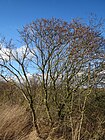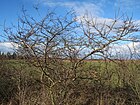Note: This is a project under development. The articles on this wiki are just being initiated and broadly incomplete. You can Help creating new pages.
Hippophae - Seabuckthorn
Sea buckthorns deciduous shrubs in the family Elaeagnaceae. It is also referred to as sandthorn, sallowthorn, or seaberry. and it is naive to Northwestern Europe, central Asia.
Contents
- 1 Uses
- 2 Parts Used
- 3 Chemical Composition
- 4 Common names
- 5 Properties
- 6 Habit
- 7 Identification
- 8 List of Ayurvedic medicine in which the herb is used
- 9 Where to get the saplings
- 10 Mode of Propagation
- 11 How to plant/cultivate
- 12 Commonly seen growing in areas
- 13 Photo Gallery
- 14 References
- 15 External Links
Uses
Inflammatory disease, Diarrhea, Pulmonary hypertension, Gastrointestinal disorder, Cardiac, Blood disorders, Skin cancer, Arthritis, Skin rashes, Metabolic disorders
Parts Used
Leaves, Young branches, Fruits.
Chemical Composition
linolenic acid (omega-3) (20-23%), linoleic acid (omega-6) (40-43%), oleic acid (omega-9) (19-22%) and palmitoleic acid (1-3%) while the major saturated fatty acid contents were palmitic acid (7-9%), stearic acid (3-4%) in seed oil[1]
Common names
| Language | Common name |
|---|---|
| Kannada | |
| Hindi | Chuk, Tarwa |
| Malayalam | |
| Tamil | |
| Telugu | |
| Marathi | NA |
| Gujarathi | NA |
| Punjabi | NA |
| Kashmiri | NA |
| Sanskrit | |
| English | Willow-Leaved Sea Buckthorn |
Properties
Reference: Dravya - Substance, Rasa - Taste, Guna - Qualities, Veerya - Potency, Vipaka - Post-digesion effect, Karma - Pharmacological activity, Prabhava - Therepeutics.
Dravya
Rasa
Guna
Veerya
Vipaka
Karma
Prabhava
Habit
Identification
Leaf
| Kind | Shape | Feature |
|---|---|---|
| Simple | Alternate | The leaves are a distinct pale silvery-green |
Flower
| Type | Size | Color and composition | Stamen | More information |
|---|---|---|---|---|
| Unisexual | 1-2cm long | Brownish | 5-20 | Flowers Season is June - August |
Fruit
| Type | Size | Mass | Appearance | Seeds | More information |
|---|---|---|---|---|---|
| Orange berry-like | 6–9 millimetres | Clearly grooved lengthwise, Lowest hooked hairs aligned towards crown | With hooked hairs | {{{6}}} |
Other features
List of Ayurvedic medicine in which the herb is used
- Vishatinduka Taila as root juice extract
Where to get the saplings
Mode of Propagation
How to plant/cultivate
Grow in an exposed or sheltered position in full sun; suitable for the mixed border or in coastal regions use as windbreak, hedging or stabilizing sand dunes[3]
Commonly seen growing in areas
Northwestern Europe, central Asia, Altai Mountains, Northern Himalayas.
Photo Gallery
References
External Links
- Ayurvedic Herbs known to be helpful to treat Inflammatory disease
- Ayurvedic Herbs known to be helpful to treat Diarrhea
- Ayurvedic Herbs known to be helpful to treat Pulmonary hypertension
- Ayurvedic Herbs known to be helpful to treat Gastrointestinal disorder
- Ayurvedic Herbs known to be helpful to treat Cardiac
- Ayurvedic Herbs known to be helpful to treat Blood disorders
- Ayurvedic Herbs known to be helpful to treat Skin cancer
- Ayurvedic Herbs known to be helpful to treat Arthritis
- Ayurvedic Herbs known to be helpful to treat Skin rashes
- Ayurvedic Herbs known to be helpful to treat Metabolic disorders
- Herbs with Leaves used in medicine
- Herbs with Young branches used in medicine
- Herbs with Fruits used in medicine
- Herbs with common name in Hindi
- Herbs with common name in English
- Habit - Herb
- Index of Plants which can be propagated by Seeds
- Index of Plants which can be propagated by Cuttings
- Herbs that are commonly seen in the region of Northwestern Europe
- Herbs that are commonly seen in the region of central Asia
- Herbs that are commonly seen in the region of Altai Mountains
- Herbs that are commonly seen in the region of Northern Himalayas
- Herbs
- Ayurvedic herbs that don't have flower, fruit and leaf photos
- Ayurvedic herbs that don't have seed photos
- Elaeagnaceae







